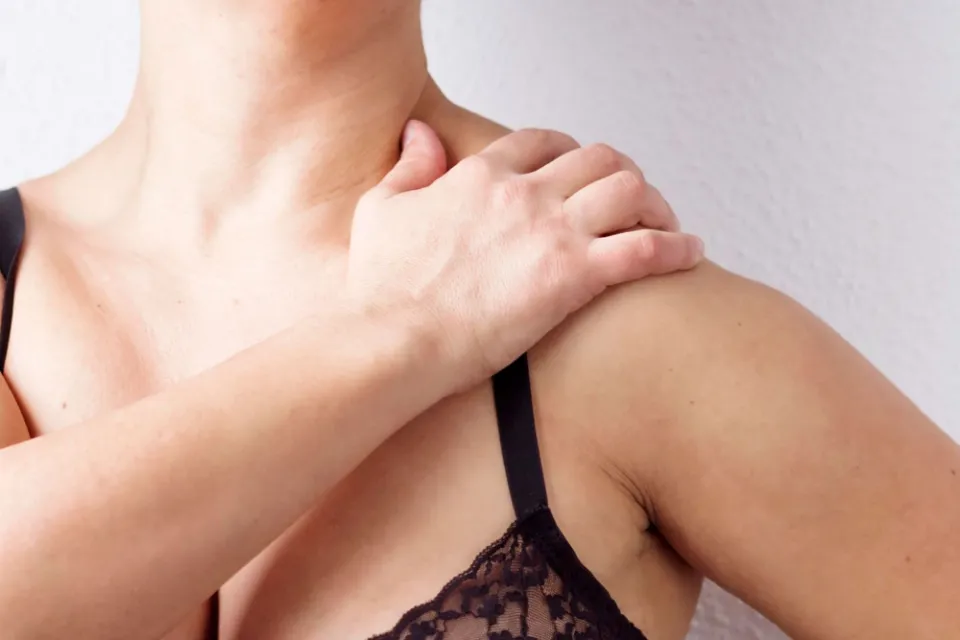You might not see how the two are related, but pain in your collarbone could indicate a stomach problem.
Your collarbone is the long, slender bone that runs from your breastbone to each shoulder and is located at the top of your chest, just below your neck.
You may ask: “I don’t understand how that relates to my stomach.”
It turns out that a sore collarbone may occasionally be a sign of a stomach ulcer, according to research.
“Shoulder pain can be the sole manifestation of a benign gastric ulcer,” researchers from the According to University of Virginia Medical Center.
Another research team who studied someone who’d suffered a gastric ulcer perforation said: “Long-lasting pain in the left shoulder was a noticeable aspect of our patient.”
According to NHS advice, a stomach ulcer’s most typical symptom is a burning or gnawing pain in the middle of the stomach.
They don’t necessarily hurt, though.
You might experience other symptoms, such as:
- Indigestion
- Heartburn and acid reflux
- Loss of appetite
- Feeling and being sick
- Weight loss
After consuming fatty foods, you might also experience bloating or burping.
“Complications of stomach ulcers are relatively uncommon, but they can be very serious and potentially life threatening,” the NHS stated.
These include:
- Bleeding at the site of the ulcer
- The stomach lining at the site of the ulcer splitting open
- The ulcer blocking the movement of food through the digestive system
If you have sudden, sharp stomach pain that worsens over time, dark, sticky, and tar-like poos, or if you have either of these symptoms in combination, call NHS 111 or your GP right away.
However, if you start to vomit blood—which can appear bright red or grainy like coffee grounds—you should go to A&E immediately.
What Other Conditions Could Cause Collarbone Pain?
Your sore collarbone could be brought on by a number of less serious factors.
However, it’s crucial to see a doctor if you hurt your collarbone or experience other symptoms in addition to unexplained localized pain.
Sleeping Position
It may be as simple as how you sleep that is to blame for your sore collarbone.
Your neck, back, and collarbone may hurt depending on how you choose to sleep, and sleeping on one side for an extended period of time may be problematic.
The pain will lessen throughout the day if your sleeping position is to blame, according to Medical News Today. New pillows or mattresses may also help, as well as adjusting your sleeping position throughout the night.
Pericarditis
According to Johns Hopkins Medicine, pericarditis can also cause collarbone pain.
Your pericardium, a delicate membrane that surrounds and supports the heart and aids in its proper functioning, becomes inflamed at this point.
The pain behind your breastbone may be particularly sharp, and it may also occasionally radiate beneath your collarbone, neck, and left shoulder. If you take a deep breath, it might feel like a heart attack and get worse; however, if you sit up or lean forward, it will get better.
According to Johns Hopkins, additional symptoms could include a fever, weakness, coughing up blood, difficulty breathing, pain when swallowing, and palpitations.
Collarbone Break Or Fracture
If pain in the affected area begins suddenly and worsens as you try to move, your collarbone may be broken.
Additionally, you might experience tenderness, swelling, bruising, or a stiff arm. You might also feel or hear grinding or clicking.
Your sore collarbone may also be caused by a condition known as distal clavicular osteolysis, which manifests as tiny fractures appearing on the end of the collarbone closest to the shoulder.
When moving your arm across your body or lifting objects above your head, you may experience pain in the shoulder, also known as weightlifter’s shoulder.
Thoracic Outlet Syndrome
If your collarbone moves from its natural position and places pressure on the blood vessels and nerves that run between the bone and your highest rib, this may occur.
According to the NHS, the syndrome can lead to pain in your neck and shoulder that radiates into your arm.
It may also impair your ability to do things like button your shirt because of the tingling and weakness in your arm.
Joint Injury
The point where the collarbone and shoulder blade converge is known as the acromio-clavicular joint. An injury to the shoulder can result in pain and swelling from a fall onto it or from a direct blow to it.
You might feel your shoulder bulge and your collarbone may be misaligned.
Osteoarthritis
According to the NHS, this is the type of arthritis that affects joints the most frequently in the UK and makes them painful and stiff.
Knees, hips, and small hand joints are most commonly affected. Your affected joints may grumble and crack as a result of osteoarthritis.
Cancer
A painful collarbone is not frequently brought on by cancer.
However, there is a very small possibility that your pain in the collarbone is due to neuroblastoma, a rare form of cancer that primarily affects infants and young children.
The nerve tissue that runs alongside the spinal cord in the neck, chest, abdomen, or pelvis is where it most frequently develops, as is one of the adrenal glands above the kidneys.
The skin, liver, lymph nodes, bone marrow, and lymphatic system are among the other organs it can invade.
Osteomyelitis
This is a rare and excruciating bone infection that typically causes pain in the long bones in your legs or the backs of your arms.
Though it’s unlikely this will be the cause of you collarbone pain, you’re more at risk for osteomyelitis if you have:
- Recently broken a bone
- Have a wound
- An artificial hip, or a screw in a bone
- Recently had surgery on a bone
- A weakened immune system
- Diabetes, especially if you also have a foot ulcer



